In the recent move toward standards-based reform in public education, many educational reform efforts require schools to demonstrate that they are achieving educational outcomes with students performing at a required level of achievement. Federal and state legislation, in particular, has codified this standards-based movement and tied funding and other incentives to student achievement.
At first, demonstrating student learning may seem like a simple task, but reflection reveals that it is a complex challenge requiring educators to use specific knowledge and skills. Standards-based reform has many curricular and instructional prerequisites. The curriculum must represent the most important knowledge, skills, and attributes that schools want their students to acquire because these learning outcomes will serve as the basis of assessment instruments. Likewise, instructional methods should be appropriate for the designed curriculum. Teaching methods should lead to students learning the outcomes that are the focus of the assessment standards.
Standards- and assessment-based educational reforms seek to obligate schools and teachers to supply evidence that their instructional methods are effective. But testing is only one of three ways to gather evidence about the effectiveness of instructional methods. Evidence of instructional effectiveness can come from any of the following sources:
- Demonstrated student achievement in formal testing situations implemented by the teacher, school district, or state;
- Published findings of research-based evidence that the instructional methods being used by teachers lead to student achievement; or
- Proof of reason-based practice that converges with a research-based consensus in the scientific literature. This type of justification of educational practice becomes important when direct evidence may be lacking (a direct test of the instructional efficacy of a particular method is absent), but there is a theoretical link to research-based evidence that can be traced.





